Places Restored, Threatened, Saved, and Lost in Preservation Magazine's Summer 2025 Issue
In each Transitions section of Preservation magazine, we highlight places of local and national importance that have recently been restored, are currently threatened, have been saved from demolition or neglect, or have been lost. Here are five from Summer 2025.
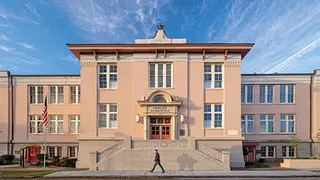
photo by: Michael Mantese
Restored: Gretna Primary School
A long-underused former elementary school in Gretna, Louisiana, has been transformed into a coworking hub just outside New Orleans. The Italian Revival–style building was completed in 1911 and housed the Gretna Primary School until the mid-20th century. It later served as administrative offices for the Jefferson Parish School Board. The German-American Cultural Center and Museum occupied the first floor of the roughly 16,500-square-foot structure for the past couple of decades, and still takes up part of that level, but the second and third floors sat vacant for at least 50 years, says architect Ben Allen of Studio BKA. Allen and his team were hired by owner Jefferson Parish and developer Formwork Development to design the building’s adaptive reuse. Now called Primary Workspace, the $3.6 million project utilized both state historic tax credits and American Rescue Plan Act funds. The team restored the original wood windows and stabilized the brick-and-stucco exterior. Remnants of the historic interior, like the school’s central hallway, are still intact. “In modern offices, the circulation spaces serve as places for impromptu meetings, or places people like to sit and work,” Allen says. “We wanted to lean into that trend in the context of this historic corridor.” The school’s former auditorium is now a common area where Studio BKA re-created the proscenium arch that once framed the double-height space’s stage. “It’s a good central place with a lot of activity,” says Allen, “and a kind of beating heart of the coworking space now.”
Restored: Essex Company Machine Shop
When the Essex Company Machine Shop was completed in 1848, it represented a turning point for the city of Lawrence, Massachusetts. “People moved to Lawrence primarily [to] work in that building,” says Scott Maenpaa, project manager at The Architectural Team (TAT). “The area itself really turned from a rural farming community into a major industrial center.” More than 175 years later, WinnDevelopment and TAT have transformed the former factory into 86 units of mixed-income housing called Stone Mill Lofts. The Essex Land and Water Company built the 149,200-square-foot structure to manufacture tools, mill machinery, and water turbines. After the building’s second owner, the Lawrence Machine Shop Company, closed in 1857, the building was sold to the Everett Mills Corporation. By the time WinnDevelopment purchased the property in 2021, the exterior of the building had changed very little. “It’s got some nice pink hues to it,” says Maenpaa of the stone facade, made primarily of granite. The team cleaned the exterior and replaced the slate roof, which was delaminating and cracking, with matching slate. The windows were replaced to increase the building’s energy efficiency—it’s now an all-electric structure—and the new ones match the look of the originals. The $39.2 million project, which utilized state and federal historic tax credits as well as Low-Income Housing Tax Credits, was unveiled in September 2024. “It really gives people a sense of place and where they came from,” Maenpaa says.
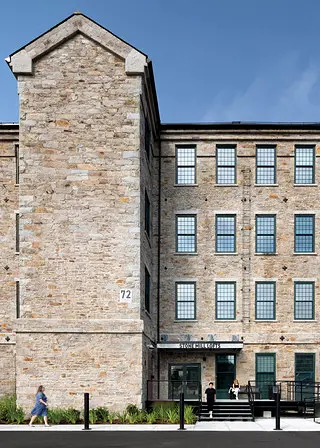
photo by: Ed Wonsek/The Architectural Team
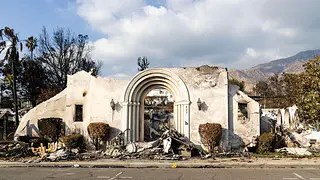
photo by: SOPA Images Limited/Alamy Stock Photo
Lost: Altadena Community Church
When public historian Tim Gregory first encountered the Altadena Community Church decades ago, he assumed the building dated to the 1920s or ’30s, given its Spanish Colonial Revival–style architecture. He was surprised to learn it was a post–World War II building, designed by architect Harry L. Pierce and dedicated in 1948. “The design can really fool you,” says Gregory, an Altadena Historical Society board member who today serves as the church historian. The congregation now faces an uncertain future after the Altadena, California, church burned in the January 2025 Eaton Fire. Original features that were lost include the sanctuary’s wood roof trusses, Judson Studios stained glass windows, wrought iron light fixtures, and a pipe organ crafted by Casavant Frères. A 1953 addition, which also burned, featured entryway tiles designed by artist Millard Sheets, a few of which survived the fire. Along with its architectural significance, Altadena Community Church had a notable history of inclusion. In 1986, amid the AIDS epidemic, the church declared itself “open and affirming” to people of all sexual orientations. “Anybody is welcome,” Gregory says. “That’s what I like about our congregation.” The church is expected to receive enough funds from its insurance payout to eventually rebuild. “It won’t be the same as it was,” Gregory says, “but at least we can do something.”
Threatened: Trinity Evangelical Lutheran Church
In late 2024, the 1886 Church Foundation was on the cusp of saving Trinity Evangelical Lutheran Church in Crown Point, Indiana. The nonprofit had a preservation-minded buyer lined up, and the building was about to have its roof replaced. Then a city board voted to demolish it, citing concerns about safety and the interested buyer’s lengthy projected restoration timeline. When completed in 1886, Trinity Evangelical Lutheran Church represented a classic example of American Gothic–style architecture, says Indiana Landmarks Northwest Field Office Director Blake Swihart. The brick structure’s original window panes and steeple were later removed, but it largely looks “as it would have,” Swihart says, as does a school building addition completed in 1938. The church was converted to apartments in the 1980s. Eventually the building became uninhabitable, and the property was transferred to the foundation, which has been working to save it with support from Indiana Landmarks. In early April 2025, the city granted the foundation another chance to find a new buyer who could come up with an approvable plan. A potential buyer came forward, and the city board expressed support for the new plan, so there is hope for the building. But after multiple false starts in the past, advocates are still worried for its future as of press time.
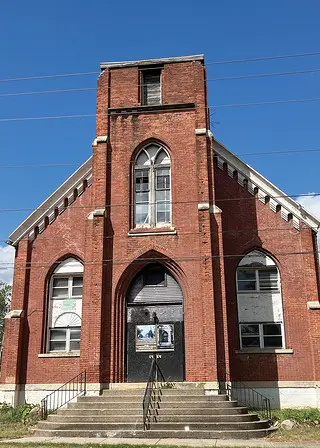
photo by: Blake Swihart/Indiana Landmarks
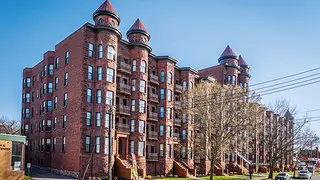
photo by: Matt Ossowski, Josh Purcell & Professional Media Services, Inc.
Restored: Olbiston Flats
When the Olbiston Flats were completed in 1898, the seven-story Romanesque Revival–style edifice was reportedly Utica, New York’s largest luxury apartment building. But by 2021, it sat deteriorating, deemed uninhabitable by the city. Now, following an $82 million rehabilitation, Liberty Affordable Housing has returned the Olbiston to its original splendor while generating 153 units of much-needed affordable housing. After a deadly 1896 fire destroyed the site’s previous structure, the Olbiston was constructed with a fireproof sandstone-and-brick exterior, thick masonry walls between units, and marble floors.
Richard A. George designed the building, which was named for its proprietors—Philip Owen, Seymour Latcher, and Emma Blanchard—whose last initials form the first three letters of “Olbiston.” The structure changed hands multiple times through the decades. When Liberty Affordable broke ground in early 2022, parts of the roof were caving in, and water had infiltrated the upper floors. The team addressed the damage, including replacing the roof, and restored the building’s most distinctive feature, the five original turrets that grace its roofline. The 158,000-square-foot building, now called the Olbiston Apartments, was unveiled in August 2024. “It was a huge boost for the city of Utica,” says Liberty Affordable Executive Director Randell Denton. “It anchors a historic section of the community.”
Donate Today to Help Save the Places Where Our History Happened.
Donate to the National Trust for Historic Preservation today and you'll help preserve places that tell our stories, reflect our culture, and shape our shared American experience.
.webp)


